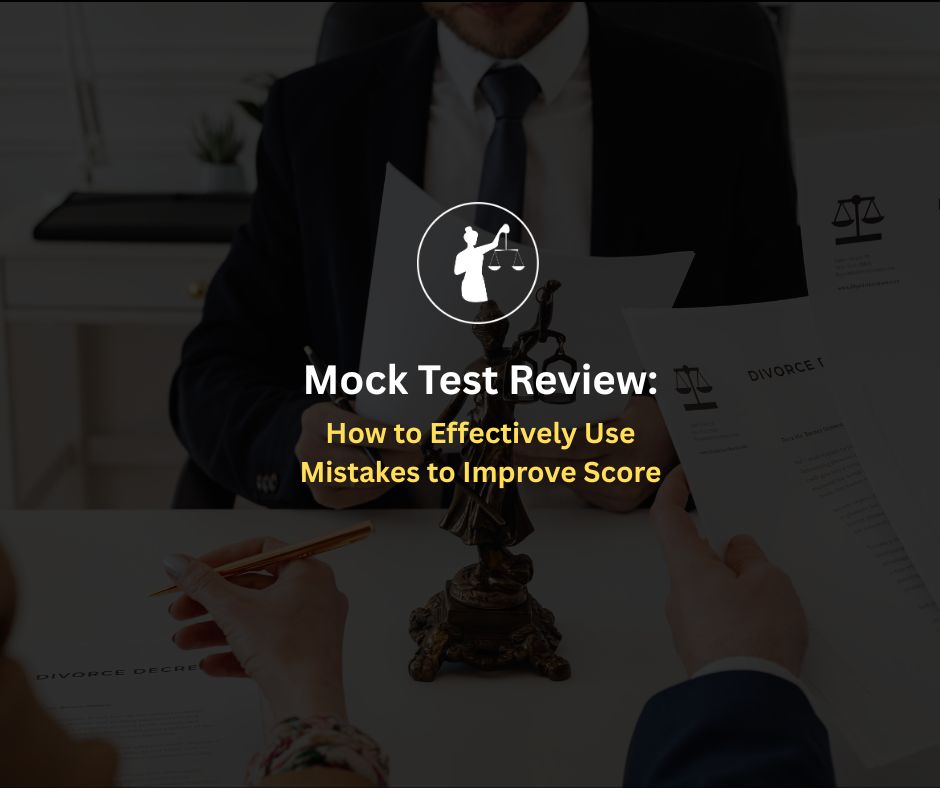
Summary-
Taking mocks is easy; learning from them is hard. Many aspirants think more mocks = better scores. But without detailed review, that’s wasted effort. In CLAT preparation, the difference between a 1000 ranker and a 100 ranker often lies in CLAT mock test analysis and the habit of digging into errors, classifying them, and fixing them systematically.
A mock is only as good as its feedback loop. The real improvement comes from converting mistakes into learning. This blog gives you a clear, practical system to do exactly that, not generic tips, but steps adopted by students who climb from 40 marks to 95 marks.
Best CLAT Online Coaching 2026–2027 by NLTI
Every mock should have a goal—e.g.:
Improve accuracy in logical reasoning.
Test time management in Quant
Reduce GK errors under time pressure
By setting targets, you know which mistakes to spot. Tracking raw scores without context is blind. Many platforms advise this structured mindset before you begin.
Treat mocks as exam rehearsals:
Fix the same duration, no break rules
No distractions or stopping mid-test
Use the same sequence of sections you’ll adopt on exam day
This builds your mental resistance to CLAT pressure, and conditions your mind where mistakes made in that environment are more relevant to fix.
Read More: CLAT 2026 Success Stories: Top Rankers’ Preparation
Right after the test (or next day), reattempt the entire mock untimed. For every question (correct, incorrect, or skipped):
Solve without reference to answer key
Note how your mind approached it
Compare your solution path with the official one
This helps surface hidden logic flaws, careless steps, or overthinking. Many CLAT prep platforms call it a “Mock Diary” approach.
Don’t just mark “wrong”, categorize why you got it wrong. Use categories such as:
Conceptual error: gap in topic knowledge
Calculation/slip error: arithmetic or algebra misstep
Misinterpretation error: misunderstanding question statement
Time pressure error: rushed decision
Guess error: blind guess with no logic
This granularity allows targeted fixes. For example, if misinterpretation errors dominate, your reading and comprehension habits need work.
Every mock’s categorized errors go into a mock-specific log. Include:
Question ID or topic
Mistake type
Your thought process
Correct method or insight
Frequency (how often it recurs)
Periodically revisit the log and see which mistake types persist. This helps you track whether your fixes are working. Many high-performing aspirants insist their “error books” account for over 30% of their improvement.
For each section:
Calculate time spent per question vs ideal time
See which sections consistently bleed time
Compare attempted vs skipped questions
Flag sections with low accuracy under time pressure
This helps you adjust the order of attempting sections, devote more practice time to slow zones, and refine pacing strategy.
After multiple mocks, you’ll spot patterns:
Certain topics always yield conceptual errors
You slow down after 40 questions (fatigue)
You guess heavily in one section at the end
Use these patterns to tweak daily and weekly strategy. E.g., introduce micro-bursts of rest, reorder section sequence, or adjust attempt limits per section.
Read More: CLAT Prep in Tamil Nadu: Beating English & GK Gaps
Weighted Mistake Scoring
Assign greater weight to mistakes from core sections (Logical, Legal) compared to GK slip errors. Prioritize fixes accordingly.
“Mirror Solving”
Swap answer choices and try solving from the wrong option backward to see how they lure you, this builds skill to avoid future traps.
Pareto Focus
80% of score gains come from fixing ~20% of recurring errors. Use error log frequency to identify which mistakes deserve immediate focus.
Peer Discussion & Review
Discuss your mistake logs with peers or mentors. Often others see your thought-flaw patterns that you don’t. One student on Reddit said analyzing mocks by sections with friends changed his consistency.
Skipping analysis: Many students jump straight to the next mock without reviewing the previous one. This repeats the same mistakes and limits growth.
Blaming difficulty: Instead of reflecting on reasoning errors, students dismiss a tough paper as “too hard.” Every difficult mock exposes gaps worth fixing.
Focusing only on wrong answers: Correct answers can hide lucky guesses or flawed reasoning. Review them too you might uncover fragile concepts.
Constantly changing strategy: Switching methods after every mock prevents you from seeing what truly works. Stick with one analysis system for at least 4–5 tests before adjusting.
The key is consistency, real progress comes from spotting patterns across mocks, not chasing perfection in one.
Read More: How NCR Students Consistently Dominate CLAT Ranks
Use this tracker after every 2–3 mocks. Enter your metrics in a simple spreadsheet, it gives you a visual growth pattern, helping you pinpoint where your strategy is working and where it’s stalling.
At NLTI, taking mocks is only half the exercise, the real growth happens in analysis. Our mentors from NLSIU work with aspirants to decode error logs, map patterns across mocks, and refine strategies based on your log data. We host mock discussion sessions, where peers and mentors dissect mistakes together, point out thought-flaw patterns, and recommend alternate approaches. NLTI’s structured system ensures you don’t just log errors, you convert them into consistent score gains for CLAT 2026.
1. How many mocks should I take for CLAT 2026 preparation?
Quality matters more than quantity. Around 40–50 mocks with deep CLAT mock test analysis after each one gives far better results than attempting 100 without review.
2. How long should I spend analyzing each mock test?
Spend at least the same time analyzing as taking it, around 2 hours per mock. Detailed learning from mocks requires checking timing, accuracy, and recurring mistakes in your log.
3. What’s the best way to maintain a mistake log for CLAT?
Create a digital or handwritten mistake log CLAT sheet with five columns: topic, question ID, type of error, reason, and correct method. Update it after every test.
4. Should I analyze correct answers too?
Yes. Even correct answers can hide flawed reasoning. A complete CLAT mock test analysis includes verifying if your logic was right or if you guessed correctly.
5. How can I track improvement using mock tests?
Compare percentile growth, not just raw scores. Record accuracy rate, attempt ratio, and recurring errors are the three most reliable indicators of learning from mocks.
6. Is it normal for scores to fluctuate in mock tests?
Absolutely. CLAT mocks vary in difficulty. Focus on trends across 4–5 tests instead of single scores. This is a key insight from every serious CLAT mock test analysis routine.
7. How do I balance between taking new mocks and revising old ones?
Follow a 3:1 ratio; after every 3 new mocks, spend a full session revising mistakes from your mistake log CLAT. It reinforces learning and prevents repeated errors.
8. How can I avoid burnout during frequent mock testing?
Limit full-length mocks to 2–3 per week. Use sectionals or mini-tests in between. The goal is learning from mocks, not mechanical repetition.
9. Do toppers maintain error logs too?
Yes. Every topper interviewed post-CLAT mentioned using some form of error or mistake log CLAT it helps track thinking flaws and monitor progress with data.
10. How does NLTI help with mock test analysis?
NLTI mentors from NLSIU guide students through post-mock reviews, identify recurring errors, and design custom improvement plans turning CLAT mock test analysis into measurable score jumps.





